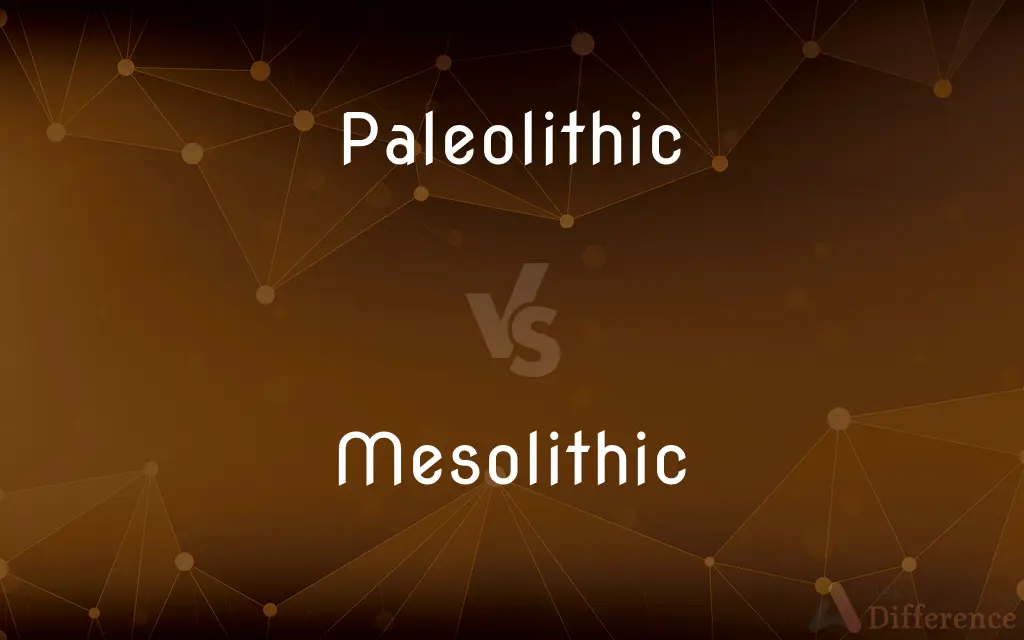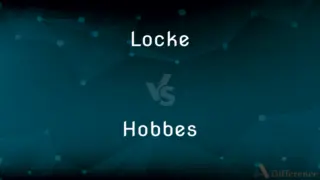Paleolithic vs. Mesolithic — What's the Difference?
By Urooj Arif & Fiza Rafique — Updated on March 13, 2024
The Paleolithic era is characterized by the use of simple stone tools and hunting-gathering lifestyles, while the Mesolithic marks a transition with more sophisticated tools and early forms of sedentism.

Difference Between Paleolithic and Mesolithic
Table of Contents
ADVERTISEMENT
Key Differences
The Paleolithic era, also known as the Old Stone Age, spans from approximately 2.6 million years ago to around 10,000 BCE. It's characterized by the development of the earliest stone tools by early humans. On the other hand, the Mesolithic era, or Middle Stone Age, occurs between the Paleolithic and Neolithic periods, roughly from 10,000 BCE to around 5,000 BCE, depending on the region. This era is marked by the invention of more advanced stone tools and the beginnings of permanent settlements.
During the Paleolithic era, humans were primarily nomadic hunter-gatherers, relying on hunting, fishing, and foraging for food. They lived in small groups and moved frequently in search of resources. Whereas, in the Mesolithic era, communities began to establish more semi-permanent settlements, reflecting a shift towards a more sedentary lifestyle, although hunting and gathering still remained essential for survival.
Paleolithic art is famous for its cave paintings and carvings, which depict animals and human figures, showcasing the spiritual and cultural beliefs of the time. While, in the Mesolithic era, art evolved to include smaller, more detailed works, such as decorated tools, pottery, and the first signs of personal adornments, indicating a development in human social structures and cultural expression.
The environmental changes at the end of the Ice Age played a significant role in transitioning from the Paleolithic to the Mesolithic era. The melting glaciers led to the creation of richer and more diverse environments, enabling humans to explore new food sources and develop new hunting strategies, which in turn fostered the advancements in tool-making and social organization seen in the Mesolithic period.
The differences between these two periods highlight the evolutionary journey of early humans, from nomadic hunter-gatherers with simple stone tools to communities on the verge of agriculture, with advanced tools, art, and the beginnings of settled life.
ADVERTISEMENT
Comparison Chart
Time Period
Approx. 2.6 million years ago to 10,000 BCE
Approx. 10,000 BCE to 5,000 BCE
Lifestyle
Nomadic hunter-gatherers
Transition to semi-permanent settlements
Tools
Simple stone tools
More advanced stone tools
Art
Cave paintings and carvings
Smaller, detailed works and adornments
Environmental Impact
Adaptation to Ice Age conditions
Adaptation to post-Ice Age environments
Compare with Definitions
Paleolithic
Groups moved frequently for resources.
Paleolithic humans migrated with animal herds.
Mesolithic
Microliths for more precise tasks.
Mesolithic arrowheads improved hunting efficiency.
Paleolithic
Hunting large animals, foraging.
Paleolithic diets heavily relied on wild animals.
Mesolithic
Evidence of social stratification.
Mesolithic burial sites show differences in grave goods.
Paleolithic
Basic tools for hunting and butchery.
The Paleolithic hand axe was used to process game.
Mesolithic
Early forms of sedentism.
Mesolithic communities began to establish seasonal camps.
Paleolithic
Expressions of early human creativity.
The Lascaux cave paintings date back to the Paleolithic era.
Mesolithic
More personal and detailed.
Mesolithic jewelry indicates personal status or identity.
Paleolithic
Small, mobile groups.
Paleolithic bands consisted of closely linked family units.
Mesolithic
Explored new food sources.
Mesolithic diets included a wider range of plants and animals.
Paleolithic
The Paleolithic or Palaeolithic or Palæolithic (), also called the Old Stone Age, is a period in human prehistory distinguished by the original development of stone tools that covers c. 99% of the period of human technological prehistory.
Mesolithic
The Mesolithic (Greek: μέσος, mesos "middle"; λίθος, lithos "stone") is the Old World archaeological period between the Upper Paleolithic and the Neolithic. The term Epipaleolithic is often used synonymously, especially for outside northern Europe, and for the corresponding period in the Levant and Caucasus.
Paleolithic
Of or relating to the cultural period of the Stone Age beginning with the earliest chipped stone tools, about 2.4 million years ago, until the beginning of the Mesolithic Period, about 15,000 to 11,500 years ago in western Asia and southern Europe.
Mesolithic
Of or relating to the cultural period of the Stone Age between the Paleolithic and Neolithic periods, marked by the appearance of microlithic tools and weapons and by changes in the nature of settlements.
Paleolithic
The Paleolithic Period. Also called Old Stone Age. See Usage Note at Three Age system.
Mesolithic
The Mesolithic Period. Also called Middle Stone Age. See Usage Note at Three Age system.
Paleolithic
Alternative case form of Paleolithic
Mesolithic
Middle part of the Stone Age beginning about 15,000 years ago
Paleolithic
(informal) Extremely outdated.
These laws are absolutely paleolithic.
Mesolithic
Of or relating to a middle period of the Stone Age (following the paleolithic)
Paleolithic
Of or pertaining to an era marked by early stone implements. The Paleolithic era (as proposed by Lubbock) includes the earlier half of the "Stone Age;" the remains belonging to it are for the most part of extinct animals, with relics of human beings.
Paleolithic
Second part of the Stone Age beginning about 750,00 to 500,000 years BC and lasting until the end of the last ice age about 8,500 years BC
Paleolithic
Of or relating to the second period of the Stone Age (following the eolithic);
Paleolithic artifacts
Common Curiosities
What types of art were common in the Paleolithic era?
Paleolithic art included large cave paintings and carvings depicting animals and human figures.
What characterizes the Mesolithic era?
The Mesolithic era is characterized by advanced stone tools, the beginnings of permanent settlements, and more complex social structures.
How did tools differ between the Paleolithic and Mesolithic eras?
Paleolithic tools were simpler and designed for broad tasks, while Mesolithic tools were more advanced, specialized, and used for specific tasks.
What is the significance of Mesolithic dietary changes?
Mesolithic dietary diversification reflects adaptation to changing environments and the exploration of new food sources.
What defines the Paleolithic era?
The Paleolithic era is defined by the first use of stone tools and a nomadic hunter-gatherer lifestyle.
Why were Mesolithic communities able to establish semi-permanent settlements?
Post-Ice Age environmental changes provided more stable and diverse resources, supporting the development of semi-permanent settlements.
How did social organization evolve from the Paleolithic to Mesolithic era?
The transition to more settled communities in the Mesolithic era led to increased social complexity and stratification.
What role did environmental changes play in the transition from Paleolithic to Mesolithic?
The end of the Ice Age and resulting environmental changes enabled richer ecosystems, leading to advancements in human lifestyles and toolmaking in the Mesolithic era.
How did Mesolithic art differ from Paleolithic art?
Mesolithic art became smaller, more detailed, and included personal adornments, reflecting changes in social structures and individual expression.
What is the importance of Mesolithic tools?
Mesolithic tools represent technological advancements and a deepening understanding of human needs and environmental resources.
Share Your Discovery

Previous Comparison
Locke vs. Hobbes
Next Comparison
Calcium vs. MagnesiumAuthor Spotlight
Written by
Urooj ArifUrooj is a skilled content writer at Ask Difference, known for her exceptional ability to simplify complex topics into engaging and informative content. With a passion for research and a flair for clear, concise writing, she consistently delivers articles that resonate with our diverse audience.
Co-written by
Fiza RafiqueFiza Rafique is a skilled content writer at AskDifference.com, where she meticulously refines and enhances written pieces. Drawing from her vast editorial expertise, Fiza ensures clarity, accuracy, and precision in every article. Passionate about language, she continually seeks to elevate the quality of content for readers worldwide.













































